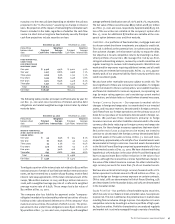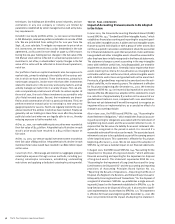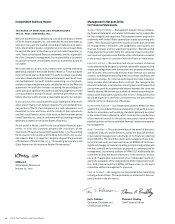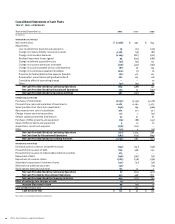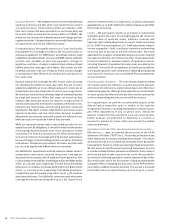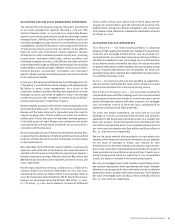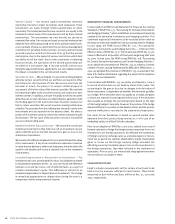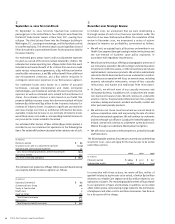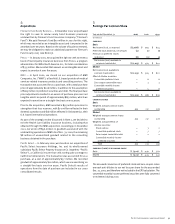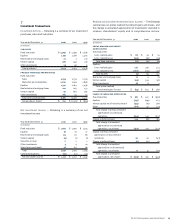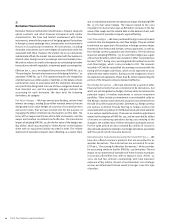Travelers 2001 Annual Report Download - page 48
Download and view the complete annual report
Please find page 48 of the 2001 Travelers annual report below. You can navigate through the pages in the report by either clicking on the pages listed below, or by using the keyword search tool below to find specific information within the annual report.
The St. Paul Companies 2001 Annual Report46
Insurance Reserves — We establish reserves for the estimated total
unpaid cost of losses and LAE, which cover events that occurred in
2001 and prior years. These reserves reflect our estimates of the
total cost of claims that were reported to us, but not yet paid, and
the cost of claims incurred but not yet reported to us (“IBNR”). We
reduce our loss reserves for estimated amounts of salvage and sub-
rogation recoveries. Estimated amounts recoverable from reinsurers
on unpaid losses and LAE are reflected as assets.
For reported losses, we establish reserves on a “case” basis within
the parameters of coverage provided in the insurance policy or
reinsurance agreement. For IBNR losses, we estimate reserves using
established actuarial methods. Our case and IBNR reserve estimates
consider such variables as past loss experience, changes in
legislative conditions, changes in judicial interpretation of legal
liability and policy coverages, and inflation. We consider not only
monetary increases in the cost of what we insure, but also changes
in societal factors that influence jury verdicts and case law and, in
turn, claim costs.
Because many of the coverages we offer involve claims that may
not ultimately be settled for many years after they are incurred,
subjective judgments as to our ultimate exposure to losses are an
integral and necessary component of our loss reserving process.
We record our reserves by considering a range of estimates bounded
by a high and low point. Within that range, we record our best
estimate. We continually review our reserves, using a variety of
statistical and actuarial techniques to analyze current claim costs,
frequency and severity data, and prevailing economic, social and
legal factors. We adjust reserves established in prior years as loss
experience develops and new information becomes available.
Adjustments to previously estimated reserves are reflected in our
financial results in the periods in which they are made.
While our reported reserves make a reasonable provision for our
unpaid loss and LAE obligations, it should be noted that the process
of estimating required reserves does, by its very nature, involve
uncertainty. The level of uncertainty can be influenced by factors
such as the existence of coverage with long duration payment pat-
terns and changes in claim handling practices, as well as the factors
noted above. Ultimate actual payments for claims and LAE could
turn out to be significantly different from our estimates.
Our liabilities for unpaid losses and LAE related to tabular workers’
compensation and certain assumed reinsurance coverage are
discounted to the present value of estimated future payments. Prior
to discounting, these liabilities totaled $948 million and $890 million
at Dec. 31, 2001 and 2000, respectively. The total discounted liability
reflected on our balance sheet was $768 million and $681 million
at Dec. 31, 2001 and 2000, respectively. The liability for workers’
compensation was discounted using rates of up to 3.5%, based on
state-prescribed rates. The liability for certain assumed reinsurance
coverage was discounted using rates up to 7.5%, based on our
return on invested assets or, in many cases, on yields contractually
guaranteed to us on funds held by the ceding company, as permitted
by the state of domicile.
Lloyd’s — We participate in Lloyd’s as an investor in underwriting
syndicates and as the owner of a managing agency. We record our
pro rata share of syndicate assets, liabilities, revenues and
expenses, after making adjustments to convert Lloyd’s accounting
to U.S. GAAP. The most significant U.S. GAAP adjustments relate to
income recognition. Lloyd’s syndicates determine underwriting
results by year of account at the end of three years. We record
adjustments to recognize underwriting results as incurred, including
the expected ultimate cost of losses incurred. These adjustments
to losses are based on actuarial analysis of syndicate accounts,
including forecasts of expected ultimate losses provided by the
syndicates. The results of our operations at Lloyd’s are recorded on
a one-quarter lag due to time constraints in obtaining and analyzing
such results for inclusion in our consolidated financial statements
on a current basis.
Policy Acquisition Expenses — The costs directly related to writing
an insurance policy are referred to as policy acquisition expenses
and consist of commissions, state premium taxes and other direct
underwriting expenses. Although these expenses are incurred when
we issue a policy, we defer and amortize them over the same period
as the corresponding premiums are recorded as revenues.
On a regular basis, we perform a recoverability analysis of the
deferred policy acquisition costs in relation to the expected
recognition of revenues, including anticipated investment income,
and reflect adjustments, if any, as period costs. Should the
analysis indicate that the acquisition costs are unrecoverable,
further analyses are performed to determine if a reserve is
required to provide for losses which may exceed the related
unearned premiums.
Guarantee Fund and Other Insurance-Related Assessments —
Effective Jan. 1, 1999, we adopted the provisions of the AICPA
Statement of Position (“SOP”) 97-3, “Accounting by Insurance and
Other Enterprises for Insurance-Related Assessments.” As a result,
we established an accrual related to estimated future guarantee
fund payments based on a three-year average of paid assessments.
We also accrue for specific known events and insolvencies. An asset
is recorded related to future premium tax offsets for those states in
which we are able to take a premium tax credit. We recorded in
income from continuing operations a pretax expense of $41 million
($27 million after-tax) in the first quarter of 1999 representing the
cumulative effect of adopting the provisions of this SOP related to
our property-liability insurance business. The accrual is expected
to be disbursed as assessed during a period of up to 30 years.



